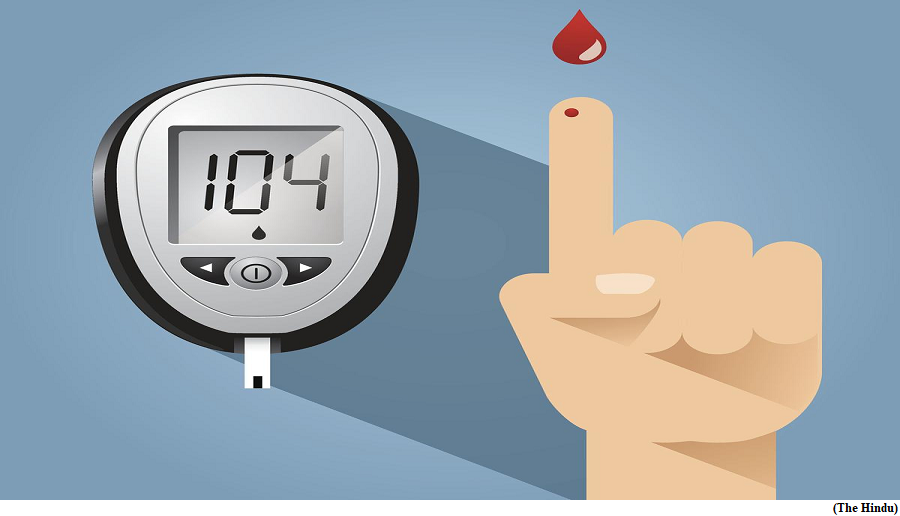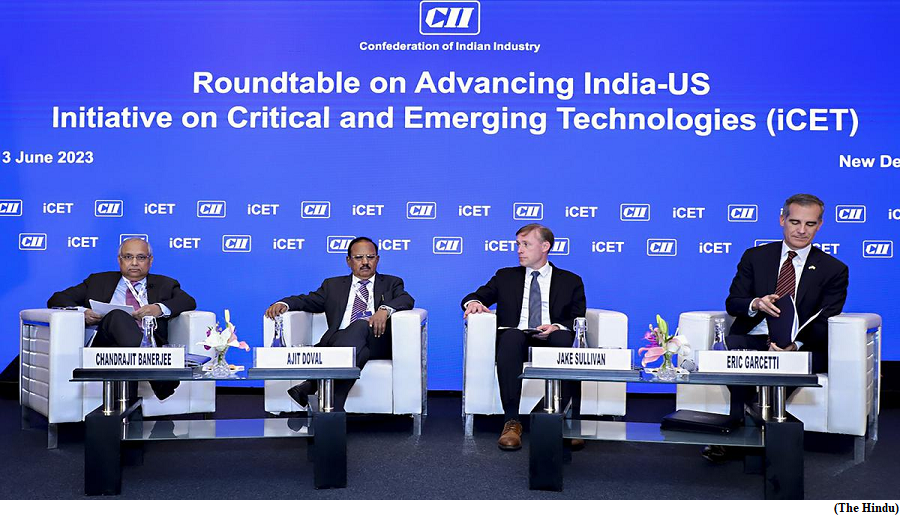How can India tackle its diabetes burden? (GS Paper 2, Health)

Why in news?
- Recently, the results of the largest, long-term (2008-2020) study on metabolic factors in the Indian subcontinent as part of the ICMR-InDiab were published.
- It was launched in 2008 to estimate the country’s NCD (chronic non-communicable diseases) burden, and done over five phases between 2008 and 2020 across the country, with each phase covering five States (all seven northeastern States were covered in one phase).
What are the key findings?
- It estimated that about 11% of the population is diabetic, and 15.3 % of the country is in the pre-diabetic stage.
- As per these estimates, 101.3 million people in the country are diabetic, and in the pre-diabetes stage, there are another 136 million people. Questions are being raised about whether this constitutes an emergent crisis in India and of the urgent methods that need to be employed to handle this situation, and control possible burgeoning of these numbers in the future.
- According to the World Health Organization (WHO), about 422 million people worldwide have diabetes, and 1.5 million deaths are directly attributed to the disease each year.
- Both the number of cases and the prevalence of diabetes have been increasing, and there is a globally agreed target to halt the rise in diabetes and obesity by 2025.
What are the implications of these statistics?
- The thing with metabolic lifestyle disorders, is that with some attention, it is possible to ward off severe complications and a morbid state of life; it is also possible to ensure that the 136 million at the pre-diabetic stage do not proceed to diabetes.
- There are multiple studies that show that poor control of blood sugar leads to complications — cardiovascular disease, kidney disease, neuropathy, blindness, and lower-extremity amputation — which then become a significant cause of increased morbidity and mortality.
- The question is whether any nation will be equipped to provide comprehensive care to all diabetics who develop complications in the course of living with diabetes.
- While it is sensible to ensure that there are sufficient facilities to treat the complications, the sagacious approach would be to launch public awareness campaigns on using lifestyle modifications to keep blood sugar within acceptable limits and complications at bay.
- Education on a mass scale should be launched across the country for control and periodic check-ups, sticking to the recommended drug regimen and reinforcing health-seeking behaviours.
- Urban India accounts for 16.4% of the prevalence while in the rural population the prevalence is 8.9%. Though the prevalence is lower now, this is an area where the possibility for prevention is greater.
Were there any surprises during the study?
- The impression was that the prevalence was high only in metro cities, Dr. Mohan says, adding that they were quite surprised to find that it was similar, or growing in 2-3 tier cities.
- In Kerala, said to be top among States with better social development indicators, the prevalence in rural areas had escalated to supersede that in urban areas.
- This is a side-effect of progress, one that States should be careful to watch over.
- All the northeastern States were covered in one phase, and the surprises included high prevalence in Tripura and Sikkim.
- While in Tripura, it was averred that the ethnic composition of the State was different from that of the other States in the region, being populated with Bengalis, leading to a high rate of 13% prevalence; in Sikkim where the prevalence of diabetes and pre-diabetes (31 %) was high, it was put down to its smaller size and relatively better socio-economic indicators there.
What is the way forward?
- There is a plan to do a cross-sectional study to gauge the actual incidence in the community.
- Some of the islands and Union Territories that could not be covered during the study will now be included in the study.
- Experts have also indicated tie-ups as part of the public-private partnership mode to involve the larger community in supporting detection and treatment for diabetes.
What’s the India, U.S. initiative on future tech?
(GS Paper 3, Science and Technology)
Why in news?
- Recently, India and the United States unveiled a roadmap for enhanced collaboration in high-technology areas, with a focus on addressing regulatory barriers and aligning export controls for smoother trade and “deeper cooperation” in critical areas.
- This was part of the Initiative on Critical and Emerging Technology (iCET) announced by US President and Indian in 2022.
- India’s National Security Adviser (NSA) and his American counterpart reviewed the progress of the initiative at the second track 1.5 dialogue on iCET.

What is iCET?
- The Initiative on Critical and Emerging Technologies is a framework agreed upon by India and the U.S. for cooperation on critical and emerging technologies in areas including artificial intelligence, quantum computing, semiconductors and wireless telecommunication.
- It was launched in January 2023 to strengthen their strategic partnership and drive technology and defence cooperation.
- Both leaders first announced the framework on the sidelines of the Quad meeting in Tokyo in May 2022.
What are the focus areas of the initiative?
- Primarily, the iCET seeks to position both nations as “trusted technology partners” to build supply chains and support the co-production and co-development of items.
- Key takeaways include setting up a research agency partnership to drive collaboration in areas like AI;
- developing a new defence industrial cooperation roadmap to accelerate technological cooperation for joint development and production;
- developing common standards in AI;
- developing a roadmap to accelerate defence technological cooperation and ‘innovation bridge’ to connect defence startups;
- supporting the development of a semiconductor ecosystem;
- strengthening cooperation on human spaceflight;
- advancing cooperation on development in 5G and 6G; and
- adopting OpenRAN network technology in India.
What has been the progress so far?
- India and the U.S. have made “significant progress” in several key areas identified for collaboration since the launch of iCET.
- The two countries have already put in place the Quantum Coordination Mechanism, launched a public-private dialogue (PDD) on telecommunication to drive collaboration in OpenRAN, 5G and 6G, and held “important exchanges” on AI and space.
- In March, India and the U.S. signed an MoU on establishing a semiconductor supply chain that paved the way for creating a semiconductor sub-committee to review recommendations from an industry-led task force launched in connection with the iCET.
- India and the U.S. have also concluded a roadmap for ‘Defence Industrial Cooperation’ to guide the policy direction for the next few years.
- Both countries have also established a Strategic Trade Dialogue to remove regulatory “barriers” and review existing export control norms to take forward strategic technology and trade collaborations envisaged under iCET.
Upcoming deals:
- On the defence front, the two countries are close to concluding a mega jet engine deal, with a final announcement expected during Indian PM’s visit to U.S.
- In addition, a new initiative to advance cutting-edge technology cooperation, known as the India-U.S. Defence Acceleration Ecosystem (INDUS-X), is set to be launched during the visit.
Way Forward:
- Both the NSAs express optimism that the initiative will achieve more specific and tangible results in the near future.
What does the alleged CoWIN data leak reveal?
(GS Paper 2, Health)
Why in news?
- Recently, reports emerged that a bot on the messaging platform Telegram was allegedly returning personal data of Indian citizens who registered with the COVID-19 vaccine intelligence network (CoWIN) portal for vaccination purposes.
- The bot shared personal details like name, Aadhaar and passport numbers upon entry of phone numbers. On the same day, the Health Ministry denied reports of a data breach, and said the allegations were “mischievous in nature.”
- It added that the Indian Computer Emergency Response Team (CERT-In) was reviewing existing security infrastructure of the portal.
What does the CoWIN portal track?
- CoWIN is a government-owned web portal set up in 2021 to administer and manage India’s COVID-19 vaccine rollout.
- The health register-style platform leverages existing public digital infrastructure like the Electronic Vaccine Intelligence Network (eVIN), an app that provides
- data on vaccine cold chains in the country;
- Digital Infrastructure for Verifiable Open Credentialing (DIVOC),
- a vaccine certificate issuer; and
- Surveillance and Action for Events Following Vaccination (SAFE-VAC),
- a vaccine adverse event tracker.
- The platform, on a real-time basis, tracks vaccines and beneficiaries at the national, State, and district levels. It monitors vaccine utilisation and wastage, and maintains an inventory of the vials.
- For citizens, CoWIN verifies identity, helps schedule vaccine appointments, and issues a vaccine certificate.
- The database captures information flowing from four separate input streams; citizen registration; health centres; vaccine inventory; and vaccine certificates. Each stream functions independently, and at the same time exchanges data to minimise redundancies.
Microservice architecture:
- The platform is a microservices-based, cloud-native architecture developed from the ground up on Amazon Web Services (AWS).
- A microservice architecture is a pattern that arranges an application as a collection of loosely linked, fine-grained services. These services interact with each other through certain set protocols.
What is the background to the data breach?
- This is not the first time reports about data leaks have emerged. In January 2022, the personal data of thousands of people in India were reportedly leaked from a government server.
- The information included COVID-19 test results, phone numbers, names and addresses of citizens. The data could be accessed via online search.
- In December, in a separate security breach, an Iranian hacker claimed to be in possession of data from the CoWIN database.
How did the Telegram bot get access to CoWIN-related data?
- Cloud providers like AWS, Microsoft’s Azure and Google Cloud typically provide security only for the underlying infrastructure, and not for securing the applications and databases. Customers hosting their data are responsible for what they build in a cloud environment.
- The absence of AWS in CERT-In’s vulnerability could mean there was no security lapse at the cloud infrastructure’s end.
- While the cloud offers superior security compared to traditional data centres, legacy systems deployed in virtual servers are the weak links in the chain. Such links are a perfect route for hackers to gain entry into a database. This shifts the focus to CoWIN, which was built leveraging legacy software tools. So, an entry point for those behind the bot may have been an old system that was connected to the portal.
- In past data breaches, cybersecurity experts have attributed data leaks to human error or negligence in setting up databases in the cloud.
What is the larger picture?
- Whatever the outcome of the CERT-In probe, the fact remains that sensitive personal data of millions of Indian citizens who signed up for the COVID-19 vaccination is in the hands of cybercriminals.
- It is unclear how they plan to use this information. But such leaks reveal India’s unfinished data protection business. A data protection law could be a useful tool in fixing accountability and building safeguards around the use and processing of personal data.
- In 2017, the Supreme Court of India recognised privacy as a fundamental right, highlighting the need to protect personal information.





